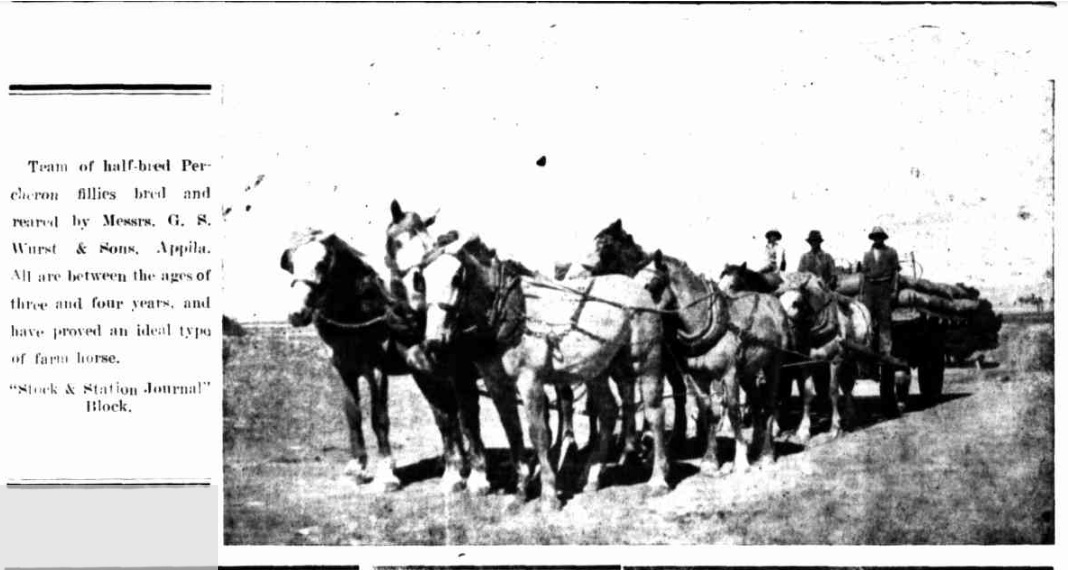Jinka and Jervois Stations

© Janet Lane, 2022. Image: Laura Standard and Crystal Brook Courier (SA), Fri 19 Apr 1940.
Read our comprehensive history of Jinka and Jervois Stations to understand more about the history of our foundation generation Walers. A list of the Jinka Walers we know about can be found here.
Jinka station (Ilperle, NT) is approximately 340 km north north-west of Alice Springs. Jervois, the adjoining station, is 380k from Alice. Mining was carried out on both places, then pastoral leases were taken up later.
In 1988 the then owner of Jinka, John Turner, was forced to sell when the government ordered the station de-stocked due to their Brucellosis Tuberculosis Eradication Campaign (BTEC), This program was aimed at getting rid of feral animals – chiefly horses and buffalo – using possible infection of exotic diseases among them as an excuse. John was given a pittance for thousands of good cattle and his only way to survive was to sell the station. There were excellent horses on Jinka, and as some were sent to the meatworks via the Alice Springs sale yards as part of the BTEC, a few were bought by Waler fans. John had taken up the pastoral lease of Jinka in 1960. The horses had a bit of heft from mining horses once in the area; he used horse for cattle work. In the BTEC times, many good horses were lost as stations were forced to send them to the meatworks or shoot them whether they wanted to or not. The only way to prove ownership was to brand them and they still had to be tested. It was impossible for some. We could only save a few. Yes, stations need to sell off excess stock and are perfectly entitled to, or shoot them if necessary, but when forced to sell or shoot by govt, the cost of mustering or hiring shooters or taking time off to do it, isn’t offset by the income; when there’s little to no return, animals suffer too. It’s a long way from the Alice Springs sale yards to horse abattoirs.
In 2021 Jinka and Jervois were granted native title under control of the Ingkekure Aboriginal Corporation. Some 5,000 square kilometres; this included a traditional stock route of 60 kilometres which was the dividing line of the stations, however it had gone on sacred land at one point, the Eaglehawk Hills dreaming, and other places of Aboriginal cultural significance. As pastoral leases usually continue when native title is granted, the determination that this sacred place forbids pastoral use (moving stock) along the stock route is in effect. The stock route cannot be used now to protect Aboriginal heritage; it had been in disuse for many years.
Jervois is 2,750 square kilometres. The Jervois Copper-Silver Project, solely owned by KGL Resources, has a mining lease over parts of the stations. Jinka Minerals is a subsidiary of KGL. In turn, KGL is owned by major shareholders being KMP Resources and Denis Wood. As well as copper, lead, zinc and silver, there are various other minerals there, some forming very pretty crystals. There’s an airstrip for the mine on Jervois.
An early copper mine on Jervois, 1920’s and on, meant strong horses were needed. Percherons were on there and Jinka, for work and breeding, putting some heft into the horses. Water on Jinka is from the Plenty River. The combined Jinka and Jervois pastoral lease was taken up by Michael Broad, his family had this for decades and still have it. Their Jervois station is a stopover on the Plenty highway. About 12,000 cattle are run there. Jervois was only taken up by pastoral lease in 1960, by the Morley family, who developed it and sold it in 1977. It was sold again in 1980. The Broads have a camping area and eco huts for travellers, showers, toilets, airstrip and shop. They get about 20 visitors a day in winter, most en-route to Kings Canyon and Uluru.
A stock route that ran through the Jervois Range from the Territory to Queensland was also a source of new horse blood as horses were sold, traded or left behind for various reasons. Mostly cattle but also mobs of horses were moved through. It was Tom Hanlon with a man named Mudge, moving horses through the Jervois Range and Tobermory, who noticed copper staining on rocks, which led to various mines being set up on Jervois and Jinka, and Jervois in particular, becoming a busy area. Hanlon himself took up a mining lease there in 1929 and 40 other mining leases were taken up and pegged out by other keen miners that year. By the late 1940’s the road became impassable to due ore carrying traffic cutting it up, and a new road was cut. Water was from Arthur Creek; at times rains brought plentiful water, other times it was dry and water was carted in, using Furphy tanks.
Lucy Creek station nearby was home to the Fogarty family, who ran cattle and had good stock horses. An article on Jervois in the Centralian Advocate, 11th June 1948, said the Aboriginal name for it was Attutra, meaning “place where the parrots get their green. Two of the early mining leases were named Attutra and Green parrot. Mining leases were also taken up in Jinka, some near Jinka Springs, A small indigenous community called Orrtipa-Thurra (formerly Bonya and Baikal) is 15 kilometres to the north of the Jervois homestead.
Huckitta and other stations border these stations with a long history of working horses and of course many becoming brumbies. They are hardy from all the attributes wild living in tough country gave them.